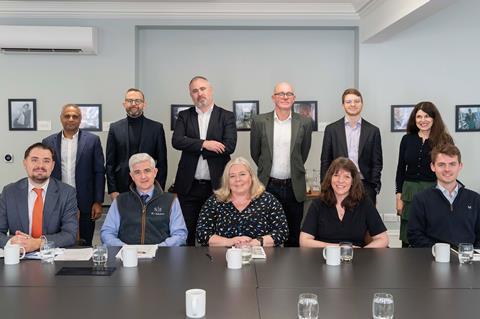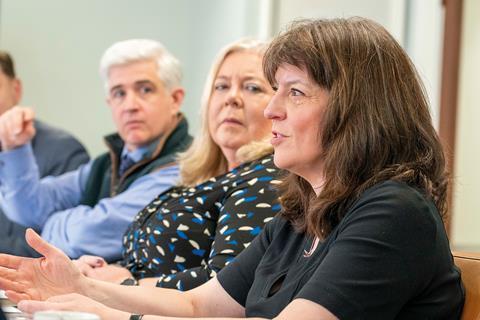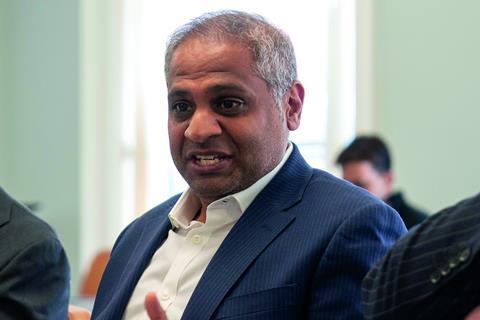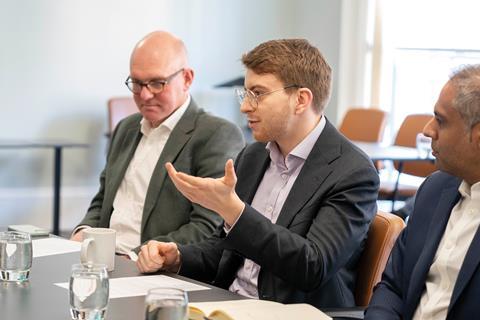For mid-market firms, the advent of generative AI is a double-edged sword. The technology can handle routine tasks and free up billable time, but also obscure intrinsic flaws in processes. Joanna Goodman reports from the latest Gazette roundtable discussion
At the table

Back row (l-r)Akber Datoo D2 Legal Technology; Miklos Orban D2 Legal Technology; Martin de Ridder Ansons; Piers Strickland Waterfront Law; Louis Debnam Thackray Williams; Joanna Goodman Technology writer and host
Seated, front row (l-r)Ruslan Kosarenko Sterling Law; Patrick Mulcare SE Solicitors; Alison Lobb Morecrofts; Elspeth Thomson David Gray; Noah Milton Fletchers
Also at the roundtable: Josephine Timmins D2 Legal Technology
While much attention has focused on high-profile generative AI (GenAI) projects in big law firms, the mid-market segment is a mixed bag when it comes to GenAI adoption. Some firms are using AI to automate and scale up parts of their operations, while others are at the beginning of their AI journey. This Gazette roundtable brought together mid-market firms whose perspectives ranged from not being entirely certain of what AI means for legal, to considering the options for investing in AI and devising AI policies. Working with large language models was also considered, as well as developing bespoke models.
Platforms and assistants
'We realised that immigration rules are easily converted into an algorithm, so we created a chatbot to help with onboarding'
Ruslan Kosarenko, Sterling Law
Sterling Law in London, which advises technology companies and private clients, predominantly on immigration law, is leveraging AI to benefit the firm and its clients. It has developed a digital platform to simplify the UK immigration process, as well as an AI legal assistant. Senior partner Ruslan Kosarenko explains: ‘A lot of clients approached us for initial assessments and advice which took up a lot of our lawyers’ time, sometimes unbillable time.
‘We realised that immigration rules are easily converted into an algorithm, so we created a chatbot to help with onboarding. This meant we were able to provide free assessments to potential clients at no cost to us.’

This has had a positive knock-on effect, Kosarenko notes: ‘The quality of our leads increased dramatically, and we expanded into other areas of immigration law. We partnered with tech firms to create a legal assistant which is integrated into our systems. It automatically creates attendance notes and next steps, and uploads them on to our CRM [client relationship management] system. It creates workflows and tasks for lawyers within our CRM and generates an email to the client confirming what has been discussed and what the next steps are. Separately, I am a co-founder of CaseCraft.AI which helps individuals submit small claims. It helps them prepare their documents and manage their cases.’
'While some of the younger lawyers are quite keen, a lot of senior people are more cautious having read the reports about hallucinations'
Alison Lobb, Morecrofts
Other firms are cautious about using GenAI for legal processes, even though they are using it in business support functions. Alison Lobb is managing partner of Morecrofts in Liverpool, which represents businesses and consumers and handles legal aid work. ‘We’ve used GenAI for templates, blogs, policies, job adverts, job descriptions, presentations and agendas, but we haven’t ventured into using it for legal work.’
She senses a generational divide. ‘While some of the younger lawyers are quite keen, a lot of senior people are more cautious having read the reports about hallucinations,’ she says. ‘We have been discussing using [GenAI] for translating instructions into a draft will, which can then be adjusted, but so far we have only got as far as talking about it.’

AI, processes and people
A popular use case for GenAI is to automate time-consuming routine tasks, freeing up lawyers to concentrate on value-added work. Noah Milton is director of AI at Fletchers Solicitors in Manchester, which specialises in personal injury and clinical negligence claims. ‘We are introducing AI to analyse medical records,’ he explains, ‘which is a key part of injury cases, to help our solicitors spend less time on that, although because we have a billable hour model, there’s not a huge incentive to use tools like Copilot just yet.’
Milton notes, however, that ‘off-the-shelf legal AI products are evolving, and at some point we’ll be in the right place to pick those up’.
Elspeth Thomson, managing partner of David Gray Solicitors in Newcastle, is also responsible for the firm’s IT. She believes that GenAI will eventually shift the law firm model away from the billable hour towards value pricing. She sees the value of applying AI to cases that involve massive volumes of documents: ‘In CoP [Court of Protection] cases, there are so many documents. They arrive in boxes to be scanned in, and a paralegal has to go through them all identifying the relevant parts. It would be a lot better if a machine could do that. You can’t take out the thinking of the lawyer, but [it would help] to point them in the right direction without having to look at all the irrelevant stuff.’
'We tend to want to put technology in as a magic bullet and automate a bad process, failing to take the necessary step back'
Akber Datoo, D2 Legal Technology
Miklos Orban, from D2 Legal Technology, emphasises the human element of AI taking over routine tasks: ‘When we think about AI, we tend to focus on efficiency and forget about the human side. When I was a trainee at Allen & Overy, for two years all I did was review documents. If the machine could do things that are super boring, it would bring something good to the whole legal profession, beyond making lawyers more productive and profitable.’
Martin de Ridder, managing director at Ansons Solicitors in the Midlands, is not sure about technology making the profession more efficient. ‘If you look back over the last 20 years, technology has added complexity and slowed things down,’ he says.

‘When I bought my first house the conveyancing process took about six weeks. Most law firms are now saying that it takes a minimum of 16 weeks. That’s with all the onboarding technology, quoting technology, communication via email, client apps and portals, yet it’s not improved the customer experience, or simplified it. The real challenge is for the technology to improve things rather than slow them down.’
'AI is a distraction because it’s shiny and exciting, but you have to look at the process first'
Noah Milton, Fletchers
Akber Datoo, founder and managing partner of D2 Legal Technology, explains that technology alone does not solve problems or create efficiency – it is equally important to look at the process and the client experience. ‘We tend to want to put technology in as a magic bullet and automate a bad process, failing to take the necessary step back. We therefore fail to see the opportunity it might bring to just do things in a very different way for the benefit of our clients and the service being provided,’ he says.
Milton agrees that introducing AI should start with the process, not the technology: ‘Loads of discussions about AI start off by saying “AI’s really good, we need to use it a lot” rather than, “What’s the process? Where do you spend 80% of your time? Can you do something differently so that you don’t have to do that process anymore?” There’s no point in spending money on making a process really quick if you could just cut it out altogether. AI is a distraction because it’s shiny and exciting, but you have to look at the process first.’

Balancing AI’s potential and risks
Although many lawyers use GenAI outside of work, they have seen news stories about the lawyers wrongly trusting its hallucinations. Consequently, some firms are deploying it in business support functions first, and using these use cases to educate the firm about its potential and its risks.
At Morecrofts, AI is used predominantly for marketing activities. ‘Our head of marketing and communications did a presentation for all our team leaders to give them some basic information [about GenAI] and show them what they could do with it,’ says Lobb. ‘If people get used to using it in their personal lives, they become less scared of it and more willing to experiment.’
Louis Debnam, IT project manager and business analyst at Thackray Williams, observes that while lawyers commonly express reluctance to use AI on the grounds of accuracy, comparisons across tasks like transcription and translation often show that it can be more accurate than a person doing the same job. ‘Lawyers need to see that they are not infallible, and while the AI might not be 100% accurate, it might be just as accurate, or more accurate, than they are,’ he says. ‘Obviously, the next question is around accountability: if a lawyer makes a mistake, they’re accountable for it, but if an AI does, who’s accountable for that?’

Datoo agrees with Lobb that for most lawyers the biggest barrier is a lack of basic understanding of AI, and how it can be applied to a law firm: ‘Being AI-ready starts with understanding it. In the last 30 years, we as lawyers have learned finance and learned business. Before that they were just lawyers, now they’re corporate lawyers. Everybody is a business adviser. I think now is the time that we have to learn the basics of technology to work in this digital age.’
Patrick Mulcare, managing director of SE solicitors in Oxfordshire, is not convinced: ‘I don’t know how electricity works, but I can use it. And while I find [GenAI] attractive, especially from a client perspective – and value pricing feeds into that – I want to see the business case.’
Piers Strickland, joint managing partner at Waterfront Law in London, is an intellectual property lawyer who advises tech companies. He notes both the potential and the implications of GenAI, including as a potential source of future work: ‘But as lawyers in a heavily regulated sector, when I speak to my partners about the upsides, they also see the risks – around the confidentiality of client data: is the AI learning about my client? Where is that knowledge going? In order for us to deploy bespoke products which meet the legal industry’s gold standard, we need to be confident in the regulator respects as well as being confident that the technology meets our business needs.’
De Ridder responds by observing that all information that comes in and out of a law firm is shared online/on the cloud at some point, if only because it is emailed. Datoo, who is co-chair of the Law Society Technology and Law Committee, refers to a general lack of awareness and understanding of what GenAI is and how it can be applied to a law firm. That is despite the Law Society publishing guidance, Generative AI the essentials, in August 2024, and the Ministry of Justice judicial guidance, published in December 2023.

Copilot trials and tribulations
Thackray Williams trialled Microsoft Copilot to summarise email conversations with clients and generate responses. As Louis Debnam explains, the idea was ‘to be able to draft an email to the client without having to review the 10 previous emails. But it’s not accurate enough yet to be really useful’.
Teams Premium licences, which include AI transcription, proved more popular. ‘Lawyers used it every day, and when we took it away after the trial, they asked for it back, whereas when we took Copilot away, they didn’t,’ he says. There is some concern that firms that run Microsoft Office default to Copilot, even though it may not be the best tool for every situation.
While GenAI tools such as ChatGPT and Copilot appear easy to use, it takes time to train the algorithm to generate the results you’re looking for. ‘We’re seeing a catastrophic lack of understanding that you need to invest time in training [large language models],’ says Akber Datoo of D2 Legal Technology.
His colleague Miklos Orban (pictured) adds: ‘If you’re waiting for Microsoft or Google to come up with a good model for legal, you’re missing the most important thing in the AI movement: that this… is the first digital tool that can be tailored to your specific needs… You can have a model that understands legal language and is trained on your platforms, fits your workflows and processes. AI… “learns you”, and that’s the big difference.’
Martin De Ridder at Ansons Solicitors believes that the SaaS (Software as a Service) model has slowed down the uptake of GenAI: ‘Sometimes it comes down to understanding what you’re using it for. I’ve never asked Copilot to do legal work, but I can get it to turn around an email that would take me maybe half an hour to write in five or 10 minutes.’

A good start
Where is the GenAI starting point for mid-market firms with limited budgets and resources?
‘The starting point is to get to a case management set-up that is lean and mean, and enables you to do things like trial Copilot on 10 computers for two weeks,’ says de Ridder. ‘We moved to a cloud-based system which has enabled us to trial different products and functionalities. But legal tech, like law itself, is very specialised. There isn’t a Swiss army knife product. We still need to integrate the case management system with our quote engines and AML [anti-money laundering] compliance tools.’
Lack of market insight is another key issue. ‘Nobody explains what products are out there and what they do,’ says Lobb. ‘We get people trying to sell us products, and we had some sessions with the Liverpool Law Society and Chamber of Commerce where people talked about what they use and what they use it for, but nobody wants to share exactly how they are using it… I would really like to be able to walk into an AI shop and look at things on the shelves, and try something for a bit to see what works for us. Then I would know what to invest in. The biggest concern is investing in something that either doesn’t work, or makes things more difficult. Because you’re not just investing money; you’re investing the time and the effort and the training and the goodwill of your people as well.’

Although there is guidance around use cases, risk and compliance, and user education, there is nothing to help mid-sized firms choose GenAI products that fit, or are easily adapted to their requirements.
Budget has to be the starting point for any tech investment. Mulcare has two concerns about GenAI: ‘The first is implementation, which means climbing the wall of fear, and not just dipping your toe in the water, but actually adopting. The second is improvement and upscaling, which is harder to budget for as things are progressing and changing all the time. Perhaps that’s always been the case, but for GenAI it feels harder.’
Milton views GenAI investment in terms of value-add. ‘Start by mapping the value of everything you could do, and choose something high value that is not too hard, if you can. Otherwise, look for quick wins,’ he says. ‘We spend a lot of time trying to understand, if we do [something] and it works as well as we think it might, what will it add to the bottom line, to our clients or our colleagues. And we always go back to the process. In many cases, we need to change the process rather than invest in something new.’
Kosarenko has partially solved the integration puzzle: ‘We found a way to integrate our legal assistant with our Clio CRM, so that from the client meeting to the email to the client, everything is automated. The lawyer doesn’t need to do anything apart from uploading the recording or transcript to our legal assistant. But our immigration chatbot sits within our sales CRM and it’s separate from our case management system.’
Data and consent
A key concern around training GenAI on legal documents is consent. Sterling Law asks for clients’ consent to process their data. It ensures that all data is held and processed within the firm’s systems, removing the risks associated with external GenAI models.
De Ridder recalls a GenAI tool being trained to read wills and produce a target list of people who might want to update their wills, together with their contact details. ‘This raises a big GDPR risk,’ he observes, ‘because if I had written my will 30 years ago, I would not have explicitly consented to having my data processed so that a bot can read it, as is currently required under GDPR rules. You can update your client engagement letter now to allow for that, but it would not have applied [then].’ This led to a discussion about the need for law firms to focus sharply on data security and GDPR compliance.
Other risks include AI use as an influencing factor in the war for talent – that is, the best graduates might not want to work for a firm that does not use the latest AI tools. Consolidation presents another AI-related risk to the mid-market as the biggest firms have more resources to invest in AI.
The road ahead
Finally, how do participants envisage GenAI’s future impact? Strickland sees Waterfront Law using GenAI in support functions rather than legal work, and is particularly interested in how it is used for marketing. ‘We’re more tentative about using it for legal work, we are adopting a watching brief until there are bespoke solutions for IP law,’ he says.
Debnam sees AI as a competitive edge: ‘Our firm is super on board with AI. We’re putting together a data and AI committee and we’re looking to integrate it where we can. It’s going to come down to the data process piece. We need to look at which part of the process we’re going to automate, and how we can get our data clean and usable, within GDPR. Any firm that doesn’t get AI working will be out-competed within a few years.’
‘As with all technology, we are over-estimating GenAI in the short term, and it won’t change much in the next one to two years,’ says Datoo. ‘In the longer term, within seven to 10 years, it will change things dramatically, therefore planning is super-important.’
De Ridder envisages an upbeat future featuring AI. ‘It’s exciting and we want to make sure we are set up to experiment and implement certain aspects of the technology,’ he says.
‘For the profession generally, it offers the potential to fill the black holes in the legal services economy, where legal expertise is needed, but it isn’t there because it doesn’t pay. AI technology is an opportunity to re-democratise legal services, and is potentially game-changing in terms of getting people access to legal advice and legal services.’
'I hope AI has a part to play in conveyancing, where I want to get the process done really quickly. But if I’m using family legal services, I am looking for a more human engagement'
Josephine Timmins, D2 Legal Technology
Orban predicts dramatic change within five to 10 years: ‘The structure of the sector will change and so will the way we do lawyering. AI will also force lawyers to be more personal as a lot of what we do now will be done by computers, so what’s left? Lawyers will have to learn two things: AI and computer science, and more intelligent emotions.’
Josephine Timmins from D2 Legal Technology responds as a user of legal services. ‘I hope AI has a part to play in conveyancing, where I want to get the process done really quickly,’ she says. ‘But if I’m using family legal services, I am looking for a more human engagement. Ultimately, you are each going to have to decide where it will fit best in your practice, for your clients and for the different people within your firms.’

Kosarenko reminds the group that ‘AI is not just a shiny tool; it is a critical part of staying competitive. However, at this stage, we should treat AI as a half-qualified legal assistant. In terms of risk, it helps a lot if you understand how to use it correctly’. Like de Ridder, he believes that AI will improve access to justice, ‘particularly in cases that are not profitable for law firms’.
Mulcare had anticipated this question. ‘When I was preparing for this roundtable, I asked AI “how important do you think you will be in the future for law firms generally?”. To which the response was, “while AI can augment and support the work of lawyers. It is not a substitute for their expertise, judgement and emotional intelligence”. Meanwhile, we are seeking a cost-effective solution and currently trialling an off-the-shelf product.’
Lobb sees GenAI as ‘a tool that we all need to learn to use in different ways. It will make a lot of difference to the way we work in terms of things like value-based pricing’. While she acknowledges that legal aid work is a barrier to adoption because it has to be done differently, she recognises that the main challenge is implementation, so she is ‘introducing more technology roles and trying to identify some champions who will take it up and tell everybody else how amazing it is’.
Thomson and Milton focus on AI as a value-add. Milton highlights the potential benefits in terms of access to justice, while reiterating that Fletchers is likely to stay in ‘harsh prioritisation mode, sticking with traditional process improvement, and understanding the value of any initiative before throwing money at it’.
Thomson, however, recalls the Richard Susskind dictum that ‘AI won’t replace lawyers, but lawyers who use AI will replace those who don’t’. She adds that the way forward is to automate the tasks that lawyers don’t like so they can focus on interpersonal skills and adding value to clients.
- This roundtable discussion was kindly sponsored by D2 Legal Technology
Photographs by Noah Da Costa






























No comments yet